St.Annes Technical School - 1907
|
ST.ANNES TECHNICAL
SCHOOL
|
|
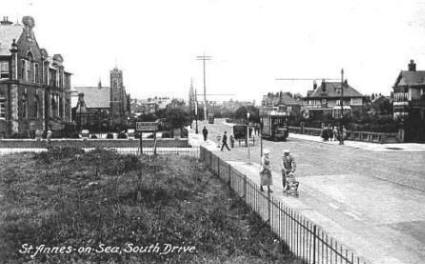
DESCRIPTION OF THE BUILDING.
|
The, St.Annes Technical School was opened on Monday afternoon
last (September 30th, 1907) by Sir Henry Hibbert, Chairman of the Education
Committee of the Lancashire County Council. Bunting was freely used from the
imposing new school and its next door neighbour-the Carnegie Free Library, and
there was every appearance of public rejoicing. Unfortunately, after three weeks of
delightful sunny weather, this was the first day of an impending change, and leaden
cloud's o'erhung the sky. No rain fell, however, and although the sun did not
favour the proceedings with his benignant presence, the function lost none of its
interest for the people who were assembled in vast numbers, nor for the
formalities, which were both picturesque and cheerful. Everything passed off
without a single hitch, and up to a late hour hundreds of townspeople made a tour
of inspection of the handsome and well equipped building.
|
|
The handsome building, which is in keeping with the general
architecture of St. Annes, has been erected from the designs of Mr. Littler, County
Architect, and the work has been carried out under the able superintendence of Mr.
G. E. Smirk, a very painstaking clerk of the works. The contract was let to Mr. T.
Cottam of Preston. The school is imposing in appearance anal solid in construction.
The outside of the building is faced with Accrington brick with dressings of Darley
Dale stone. After passing up the fine stone steps at the front a spacious arched
porch is entered. At the end of the porch are swing glass doors, which bear the
crest of the St. Annes Urban District Council in stained glass. These doors lead
through a fine arch to the large entrance hall, 27ft. by 18ft.
|
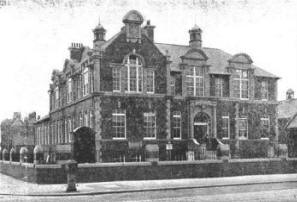
|
|
This ENTRANCE HALL has a handsome tiled dado to a height of 3ft.
6in. carried all round, and also along the two main corridors which lead from the
hall. The floor, lavatories and corridors are all marble terrazzo. On the right and
left of the large hall the the teachers' and' secretary's rooms, the walls of which
are of duresco with colour to the ceiling. Opening from the main corridor are the
No. 3 classroom, the lecture room, a preparation room, and a laboratory for 25
students. In the laboratory is a balance-room, a number of fumed closets for
testing purposes, and a dark room.
Separate benches for the students are fitted in this room, the tops of which are of
teak to obviate as far as possible the action of chemicals. Separate sinks are
fitted in the benches, and they waste effluents from these benches are carried
through glass-lined pipes into the yard. The bottoms of the fumed closets are lined
with slate and glass, and in addition are fitted with flues built in the wall,
which discharges into the open air.
The whole of the fittings of the laboratory are of the most approved and up-to-date
style. The room is exceedingly well lighted by a number of windows on the south
side, and special attention has also been paid to the ventilation. Throughout the
entire building the rooms are LARGE AND AIRY, much attention having been directed
to the provision of plenty of light and pure fresh air.
The chemistry lecture hall, which is divided from the laboratory by the preparation
room, can be enlarged by the removal of a glass screen, so as to include classroom
No. 1. The floor of the room is of pitch pine with a bitumen preparation laid
between the pitch pine and the concrete to prevent dampness. The lecture ¬room is
designed for 50 students, but with the addition of classroom No. 1 nearly 80
students can be accommodated. On the right of the entrance hall are classrooms Nos.
2 and 3, which have a glazed brick dado to a height of 3ft. 6in. all round. They
are well lighted and ADMIRABLY VENTILATED. Provision is made for 24 students in
each room.
|
|
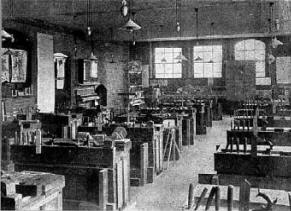 The oak desks are of the single
type, with a locker for materials. A corridor on the right of the entrance
halls leads to the boys' lavatories, which are equipped with all the latest
conveniences. From the main corridor a flight of concrete stairs leads down to
the basement hall. In the basement is a large workshop fitted with twenty
joiners' benches. The oak desks are of the single
type, with a locker for materials. A corridor on the right of the entrance
halls leads to the boys' lavatories, which are equipped with all the latest
conveniences. From the main corridor a flight of concrete stairs leads down to
the basement hall. In the basement is a large workshop fitted with twenty
joiners' benches.
The heating throughout is by hot water on the low pressure
system. The rooms in the basement are well lighted by windows, an area having been
left so that the grounds do not affect the light. Two large rooms, at present
unused, have been extended, so that if necessary classes in plumbing or electricity
may be held. In addition there is a large room that may be used as a gymnasium.
There is a separate entrance to all the rooms in the basement from the large yard
at the rear of the Technical School.
|
|
From the entrance hall a. flight of concrete stairs lead to the'
rooms on the second floor. The staircase window is of very chaste design. The
Lancashire red rose has been introduced into the margin and side lights with fine
tinted amber and Cathedral muffled glass as a filling in. The window is very finely
arched, and is quite a feature of the staircase. This window lights both staircases
and part of the corridors.
To the right on the second floor is the large WELL ARRANGED COOKERY ROOM 41ft. 6in.
by 22ft. 6in., which is designed for 31 working students. There are three workers'
tables in the centre of the room with a long table alongside the South wall. At one
end of the room is a fine, large cooking range with gas cookers on each side. In a
recess 12ft. by 7ft. 3in. are sinks, plate racks and cupboards. This room also
possesses a glazed dado 3ft. 6in. high.
In this room great care has been taken with the ventilation and the fumes of the
gas are carried through pipes in the walls. Classroom No. 4 adjoins the cookery
room, and it will accommodate 25 students. It is well lighted having windows on two
sides, and is lined with a dado similar to the cookery room.
The room is fitted with cupboards for dressmaking and millinery purposes. Adjoining
the room is a stove which may be used by the dressmaking, millinery, or cookery
students. From the 6ft. 6in. corridor opens the large art room, which is 43 feet by
28 feet 6in. This room has an open roof, and is well lighted by two large skylights
and several windows on the East and North sides. The floor of the art room is
fireproof, having a. course of bitumen between the boards and the concrete.
|
|
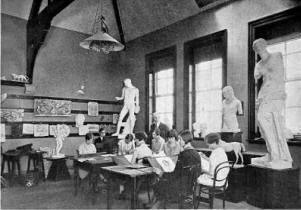 The arrangement of the ART ROOM
has been admirably carried out by Mr. J. W. Clegg, the teacher of art. The
prin¬ciple that the human figure is perfection in art has been recognised, and
the art room has been furnished accordingly. Students will be taught to draw
the human figure in all its stages, anatomical and physiological. Several
casts of Greek sculpture are included in the furnishings - the Venus de Milo,
the Discobolus of Myra, a Gladiator, the Dancing Faun, a Metope of the
Parthenon, Athens, by Phidius (one of the Elgin marbles), and a Hercules from
the bronze in the British Museum. The arrangement of the ART ROOM
has been admirably carried out by Mr. J. W. Clegg, the teacher of art. The
prin¬ciple that the human figure is perfection in art has been recognised, and
the art room has been furnished accordingly. Students will be taught to draw
the human figure in all its stages, anatomical and physiological. Several
casts of Greek sculpture are included in the furnishings - the Venus de Milo,
the Discobolus of Myra, a Gladiator, the Dancing Faun, a Metope of the
Parthenon, Athens, by Phidius (one of the Elgin marbles), and a Hercules from
the bronze in the British Museum.
There are also a large number of casts of a decorative char¬acter. Whilst dealing
with the art room it may be mentioned that the photogravures of the work of 24
English artists have been hung in the corridors and rooms, these being:-"Hope"
(Watts), "Sun of Venice going to sea" (Turner), "Age of Innocence" (Reynolds),
"King Cophetua" (Burne-Jones), "Christ and Peter" (Madox Brown), "Portrait of
Carlyle" (Whistler), "Dante's Dream" (Rossetti), "Echo and Narcissus" (Waterhouse),
"St. Bartholomew" (Millais), "The Sea gave up its dead" (Leighton), "Light of the
World" (Hunt), "Forest Oaks" (Waterlow), "Spaniels" (Landseer), "Israel in Egypt"
(Poynter), "Pastoral" (C. Lawson), "Death's Door" (W. Blake), "No. 19" (H.
Holbein), "Proserpine" (Sandys), "The Glebe Farm" (Constable), "Trafalgar"
(Stansfield), and "Oliver Cromwell" (Lely). A portrait of Matthew Arnold also
adorns the walls.
Adjoining the art room is the teachers' room with a lavatory attached. On this
floor also are the girls' lavatories and cloak-rooms, divided from the teachers'
room by a caretaker's room. A new feature has been introduced in the division of
the lavatories and cloak-rooms by a thin concrete breeze partition, the face of the
breeze being finished in the usual way. The grounds outside have been tastefully
laic out and planted with shrubs and trees.
|
|
THE SUB-CONTRACTORS.
The sub-contractors for the various work at the Technical School are:-Plumbing
painting and glazing, Messrs. Marsden Preston; plastering, Mr. T. Walker, Black
pool; fireproof work Mr. Robt. Rayner, Manchester ; tarrizzo work, Messrs.
Patterson Manchester; tiling, Messrs. Williams, Manchester laboratory and other
fittings Messrs. Greenhalgh, Warrington; electric lighting, H. Leake and Co.,
St.Annes; fire places, Messrs. Gill and Read, St. Annes furnishing, Messrs. J.
Heywood and Co Manchester; iron railings, Messrs. Cunliffe and Dean, Manchester;
grounds, H. Heptin¬stall, St. Annes; ventilation, Messrs. Har¬grave,
Bury.
THE LUNCHEON.
Coun. Thompson entertained Sir Henry Hibbert and other guests to Luncheon at the
Grand Hotel. The invited guests were: Coun. Thompson, J.P., who presided; Sir Henry
Hibbert, Miss Hibbert, Rev. H. E. Butler (Vicar of St.Annes), His Worshipful the
Mayor of Blackpool (Conn. S. Hill), J.P., Mr. Thos. Loftos (Town Clerk of
Blackpool), Mr. Jas. S. Fair, J.P. (County Council representative for Lytham and
St. Annes), Mr. Harcourt E. Clare (Clerk Lancashire County Council), Mr. Thos
Bradley (Clerk St. Annes Council), Coun. R. H. Irving (Chairman Higher Education
Committee), Coun. S. L. Stott, J.P., Mr. H. Littler (County Architect), Dr. Snape
(Director of Education, Lane. C.C.), Mr. W. Wilson (Secretary Higher Education
Committee, 'Lancashire C.C.), Mr. Mr. N. Thompson (St. Annes), Ald. Cunliffe, J.P.,
Rochdale, Mr. J. Hamer, Rochdale, Dr. Smith, West Kirby, Mr. Gen. Webb, Bury
(Chairman, St. Annes Land and Building Company), Couns. T. Ferguson, H. D.
Rothwell, J. Hallam, N. Walmsley, J. Whiteside, A. England, and J. E. Stonex; Mr.
W. Shorrock (contractor), and Mr. Jas. Bowman (senior teacher, Technical
School.
The menu was as follows, the dainty viands being served' in Mrs. Holloway's best
style: Oysters. Turtle Soup. Mayonnaise of lobster. Sirloin of beef. Saddle of
Mutton. Pigeon Pies. Spaced beef. Surrey fowls. York ham. Braised tongues. Sherry
Jelly. Strawberry Cream. Apple tarts. French pastry. Dessert.
SUCCESS TO THE TECHNICAL
SCHOOL.
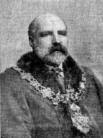 Coun. Thompson, who presided,
submitted the toast of "The King," following which Coun. R. H. Irving
(Chairman of the Higher Education Committee) proposed "Success to the
Technical School." It seemed to him somewhat novel to be proposing success to
the new Technical School when they considered that some thirty years ago or
more they were laying the foundation-stone of the Hotel, which was the first
building in the district. Now they had provided an up-to-date Technical
School, one, they would admit, which reflected great credit upon the architect
(Mr. Littler), the contractor, and all concerned. (Hear, hear). Coun. Thompson, who presided,
submitted the toast of "The King," following which Coun. R. H. Irving
(Chairman of the Higher Education Committee) proposed "Success to the
Technical School." It seemed to him somewhat novel to be proposing success to
the new Technical School when they considered that some thirty years ago or
more they were laying the foundation-stone of the Hotel, which was the first
building in the district. Now they had provided an up-to-date Technical
School, one, they would admit, which reflected great credit upon the architect
(Mr. Littler), the contractor, and all concerned. (Hear, hear).
The County Council had imposed upon St.Annes A GREAT RESPONSIBILITY; they had
entrusted them with the first Technical School they bad erected, "and," added the
speaker, "We intend to make that school a great success." (Hear, hear). They had
been labouring for some years under disadvantages. They had attained some little
success under those circumstances, but they had now bright and lofty rooms, and
they thought that with the efforts they were making and those they intended to make
that St.Annes would stand out, not only as a great health resort but as a great
educational resort as well. (Hear, hear). It was true they had no industries in the
town. They built people's health up; when they were broken down in health they gave
them a new lease of life. They had been trying to improve the raw material, and
they recognised that the great difficulty had been, when they had treated the raw
material, how to continue it afterwards. These Technical Schools which were
springing up in different parts of the country were intended to complete what had
been done in the elementary stages. He hoped they would carry on, very
successfully, these continuation classes and so fit those living in the town to
participate, and go forth, not only well-equipped' constitutionally, but well
¬equipped mentally. One recognized in these days that the more efficient we were
the more able we were to combat the invasion of nations, and it was the great end
of all communities to truly educate in the broadest and' fullest extent possible
the young people and men of our day. (Applause).
 Sir Henry Hibbert responded to
the toast, and said there was a need of Technical education because the
education of a boy or girl was not finished after leaving the elementary
school. He had had cases brought before his notice where boys had had the
benefit of a good, sound education who had not been able to pass the entrance
examination into a secondary school because numberless subjects which were of
intense importance to them, had been neglected in that public school; and
therefore there was a very great need of the opportunity of Sir Henry Hibbert responded to
the toast, and said there was a need of Technical education because the
education of a boy or girl was not finished after leaving the elementary
school. He had had cases brought before his notice where boys had had the
benefit of a good, sound education who had not been able to pass the entrance
examination into a secondary school because numberless subjects which were of
intense importance to them, had been neglected in that public school; and
therefore there was a very great need of the opportunity of
CONTINUED EDUCATION.
The question of finance provided another reason
why a Technical School had been erected in St.Annes. The ratepayers in that and
neighbouring localities paid their rates and naturally said: "If we want a
little more education for our children why should we have to send them on the
railway train, sometimes at a very great cost?" It was true that was not an
industrial population, but the sole purpose of education was not to make money,
and there were subjects which could be taught which would be of incalculable
importance in after life. Without dilating further on the reasons for the
erection of the school he would at once say the school was necessary, and he was
very glad indeed that it was being opened that day. (Hear, hear). They owed it,
probably, to their Town Clerk. Had it not been for the persistency of Mr.
Bradley in sitting on the doorstep of the "L.G.B." they would not have got at
Technical School, at all events, for several years. (Applause). Coun, Stott,
J.P., proposed "The Lancashire County Council." When he (Conn. Stott) spoke four
years ago on the increase of the Poor Rate-it had doubled in two years-he
concluded that the County Council were spending too much money. It was very nice
for those who spent so long as they let other people gather the money, and
unfortunately, he, as an Overseer, was one of the persons responsible for
getting the money. And now he had got to propose the welfare of the County
Council and its success in administration.
He had pleasure in proposing the toast. When one looked at the vast amount of work
carried on by the county Council, such as the main roads, the policing of the
County, and elementary and higher education, he, must recognise that the expenses
must be very heavy. Looking at the finances of the County he found them in a MOST
HEALTHY CONDITION. Their receipts from all sources last financial year were
£1,600,000, and their payments amounted to £1,280,000, which left a very
substantial balance in hand. The income of the County fund was £500,000 after
allowing for the precepts from the standing committees. He asked them now, as then
practise economy. Elementary education cost over half-a-million-£517,000-and had a
balance of £41,000, which was not whit too much to carry on the work. Higher
Education the receipts were £220 and they had a balance in hand of
£100,000.
|
|
|